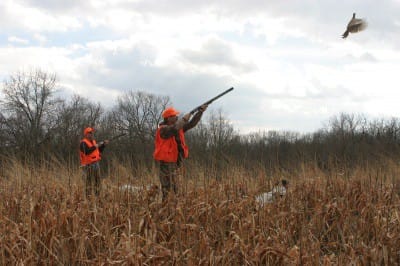
As a native of South Dakota, the bona fide “Pheasant Capitol of America,” I know the reality of hunting pheasants in both large- and small-habitat environments. Look at this way, hunting pheasants in large fields is like trying to corner a herd of wild pigs in a big barn. Unless you have a lot of help expect them to squirt between your legs in a squealing escape. Attempt the same maneuver in a small shed and you’ll have greater success. For the best success on pheasants, especially when hunting with a partner or two, target small parcels.
Two or three hunters can find success, but it takes an analytical review of the cover and surrounding terrain to fill your game bag at the end of the day. First, look beyond your property and locate the next parcel of habitat pheasant escapees will target if they escape your shot pattern. This is important, even if it is on the neighbor’s property. If you recognize the natural escape route the birds will take you can cut them off. Pheasants are strong flyers, but only for short distances. They’ll ditch into cover a half mile away instead of trying to flying across a mile-long field. Plus, if the next available cover is on your side of the fence, you have the makings for another ambush.
Secondly, scout the perimeter of the cover. Does it provide any natural blocking abilities that will prevent pheasants from escaping without flushing? A deep gorge, harvested crops, a lake or even a road can stop pheasants like a garage sale sign stops a grandma. When you work to the end of such a scenario, slow down and let your dog, plus the nerves of the pheasants work for you. If you stop in the last 10 yards of cover or so the pheasants should naturally flush from nail-biter tension.

Another tactic involves the repeat of a hunt. Pressured pheasants quickly learn that holding tight means survival, but working the cover twice is almost too much for even a pheasant with nerves of steel to take. Hunt the field into the wind first to give your dog an advantage in smelling tight-sitting birds. Instead of leaving when you reach the field’s end, turn around and hunt it back again taking your time. You won’t be flushing swarms of pheasants, but you stand a good chance of finishing out your limit with a tight-sitting rooster.
Flushing dogs are the species of choice across pheasant country, but when hunting pockets of small cover pointers provide an effective adversary against tight-sitting roosters. Small cover is also not as frustrating for pointing dogs that can go schizophrenic in hotspots loaded with hundreds of birds. Instead of trying to pinpoint one rooster in dozens of scent trails, pointers work well in small areas holding only a handful of roosters.
Hunting large fields with a truckload of buddies is a social event worthy of any weekend, but you’ll be just as successful with a partner targeting a small property. The sight of hundreds or thousands of birds may not greet you, but you’ll challenged, entertained and just as successful.

Contact:
Warne Ranch Hunts;www.warneranches.com
Halverson Pheasant Hunts;www.pheasantsrus.com







